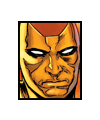
Booster Gold
“The Big Fall”
Volume 1, Issue 1, February 1986
Released October 29, 1985
Cover Price: 75¢
Guide Price: $50.00 (as of 2016)
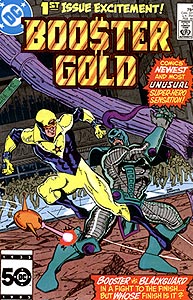
Writer: Dan Jurgens
Penciller: Dan Jurgens
Inker: Mike DeCarlo
Colorist: Tom Ziuko
Letterer: Augustin Mas
Editor: Janice Race
Cover Artists: Dan Jurgens, Gaspar Saladino
Hero: Booster Gold
Villains: 1000, Blackguard, Mindancer
Supporting: Cindy Mills, Conrad, Dirk Davis, Doctor Klyburn, Jack and Jill, Jan the Juice Barrista, Jimmy Olsen, Myron, Senator Ballard, Skeets I, Skip Andrews, Trixie Collins
Setting: Metropolis, DCU, USA, 20th-century
Cover Description: Booster Gold and Skeets battle Blackguard on a city street.
Brief Synopsis: Metropolis's new public hero number one, Booster Gold, accidentally encounters and fights agents of an unknown organization, including the brute Blackguard, recovering then losing a top-secret guidance system.
Issue Summary: Reveal Potential Spoilers
Booster Gold's role in this story:
Featured (Booster Gold plays a prominent role)
Costume Worn: MARK I power-suit
Issue Notes: Booster Gold is the first original character introduced into DC continuity following the conclusion of the universe-changing events in the Crisis on Infinite Earths series. Booster Gold and his supporting cast were created by series writer and artist Dan Jurgens.
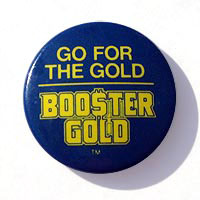
The 1-1/8 inch metal pin pictured above was provided by DC Comics to direct market distributors to promote the release of the new series. (Pin provided by Mike Harlow.) This series was also promoted via house ads that prominently include Booster Gold.
This story has been reprinted in:
Booster Gold SDCC 2023 Facsimile Edition (2023)
Booster Gold: The Big Fall (2019)
Showcase Presents: Booster Gold (2008)
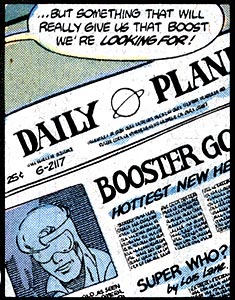
Page 1, panel 1
EXTRA, EXTRA: First mention of Booster Gold. We are introduced to Booster Gold whose image headlines an issue of the Daily Planet newspaper: "Booster Gold, Hottest New Hero" Booster is an established hero in Metropolis before his first appearance, clearly indicating that the Booster Gold story doesn't start here. Note that the story below the article about Booster was written by the Daily Planet's star reporter, Lois Lane, the long-time love interest of Superman.
Page 2, panel 1
FIRST APPEARANCE: First Appearance of Booster Gold, sans costume, running inside the Metropolis Athletic Club. Despite wearing no costume, he is called "Booster" by everyone in the gym. While there is no evidence of Booster's powers or abilities, he clearly maintains himself in peak physical condition.
Page 2, panel 2
SILVER SCREEN: While exercising Booster is also negotiating a deal to appear in his own Hollywood movie, tentatively titled "Booster Gold The Motion Picture." Booster's salary demands result in a comparison to Sylvester Stallone, the star of two of the top-grossing movies of 1985 (Rambo: First Blood Part II and Rocky IV) for which he was reportedly paid $15,000,000 each. Comparatively, Booster is requesting a $5,000,000 salary to portray himself.
Page 2, panel 3
BUSTER GOLD: First appearance of Senator Ballard (unnamed) who calls Booster "Buster," establishing a running joke that will continue periodically throughout the run of the series and well into the future.
Page 3, panel 1
FASHION ALERT: The debut of Booster Gold's costume. This costume, the classic Mark I or "Original" power suit, notably includes a high collar, gold cape, and a gold center in the blue star on Booster's chest. The high collar is similar to the cape of Dr. Fate. The design and color of the star would change frequently, sometimes panel by panel, as it evolves over the next few issues. (Jurgens will later admit in the letter column of issue #18 that the star changed because of lack of coordination between the pencillers, inkers, and colorists on the book before it was standardized as blue.) Booster sports a hairstyle featuring long bangs. Like his costume, Booster's hairstyle will change frequently over the years to come.
Page 4, panel 2
HIS STORY: In a rare case, Booster turns down an opportunity to endorse Chem Tech, claiming that they will be bankrupt within a year. This suggests that Booster only chooses to endorse companies that he knows will do perform well, tying his name to winners.
Page 5, panel 1
BOOSTERRIFIC! COUNT: 1. Booster first uses his catchphrase, "Boosterific!" [sic] The word is usually spelled with two "r"s and one "f," though an additional "f" will be added on occasion. As the series develops, it becomes clear that Booster's favorite exclamation of joy is "teriff," clearly a derivative of "terrific" with an emphasis on the "f" sound.
Page 6, panel 1
FIRST APPEARANCE: First appearance of Skeets, Booster's football-shaped, flying robotic companion. Skeet's visor in this first appearance is shaped like a stylized "v," but will become more "t"-shaped in future issues. (In future appearances, Skeets will later insist that his prolate spheroid shape was designed for aerodynamic performance, similar to the manner in which a rugby ball was re-shaped for the modern passing game of American football.) Continuing the American football theme, Booster will often affectionately refer to Skeets as "Coach."
Page 6, panel 3
FIRST APPEARANCE: First mention and exterior shot of Booster Gold's corporation, Goldstar, Inc.
Page 6, panel 4
FIRST APPEARANCE: First published appearance of Dirk Davis, Booster's agent. Dirk informs Booster that he has landed a role on the TV show Love Cruise, as the superhero who saves the ship from a terrorist attack. The name of the fictional television show is clearly inspired by the popular Aaron Spelling produced television show The Love Boat, which aired on ABC from 1977 to 1986.
Page 6, panel 6
FIRST APPEARANCE: First appearance of Booster's secretary, Trixie Collins, and the interior of Goldstar, Inc.
Page 7, panel 1
Booster discusses the Justice League over his limousine telephone with Trixie: "I'm sure they're going to want me as a member! They may even ask me to be Chairman!" Booster's future history with the Justice League will be a long and convoluted one. Whether Booster is aware of his future with the League is debatable.
Page 8, panel 4
POWER UP: Shortly after displaying the power of flight, Booster first demonstrates a ranged ray attack, apparently from his hands or wrists. He calls this ray attack the "Booster Shot." Medically, a "booster shot" is a supplemental inoculation to reinforce previous vaccinations. In retrospect, this name is perhaps a bit ironic considering the coming events of Booster Gold Vol. 1, issues #13 through #15.
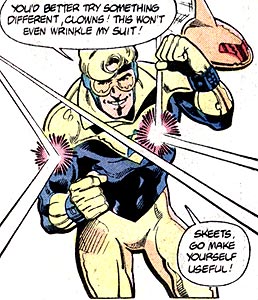
Page 9, panel 1
FASHION ALERT: Preparing to chase a large truck recklessly driving down the street, Booster removes his cape. Booster's cape (usually colored gold outside, white inside) is more for dramatic show than anything else, a vestigial costume element that ties Booster to costume design of the past, but is removable for battle, demonstrating his modern sensibility. (In a later letter column, Jurgens comments that Booster uses the cape for "the 'reality quality' it adds to press conferences and such." Jurgens certainly didn't need the cape as a prop to display motion, as many artists in the past have done. In fact, John Byrne's modern Superman costume redesign - more a tweaking than an overhaul - would feature a larger, more dramatic cape, emphasizing the difference between the archetypal superhero costume and Booster Gold's sleek, modern design.
Page 9, panel 3
FIRST APPEARANCE: First appearance of the 1000, the organization that will become Booster's bane for the early portion of his career.
Page 9, panel 4
POWER UP: Booster first demonstrates the power of invulnerability, shrugging off bullets.
Page 10, panel 1
POWER UP: Skeets first demonstrates a ranged ray attack from his visor. The ray is accompanied by the sound effect "ZZZAP!"
Page 11, panel 1
FIRST APPEARANCE: First appearance of the villain Blackguard.
Page 14, panel 2
POWER UP: Booster first demonstrates the power of object teleportation by displacing a police car thrown at him by Blackguard. He calls this power the "Mass Dispersal Force." Despite (or perhaps because of) the clearly demonstrated awesome power of this ability, Booster will rarely use this power in the future.
Page 15, panel 1
Cameo appearance by Jimmy Olsen, reporting for WGBS News. This is one of many anachronistic elements apparent in Booster's early interactions with the "present-day" DC Universe. It would soon be established that in post-Crisis on Infinite Earths DC Universe continuity, Jimmy Olsen was never a television reporter at all, creating something of a time paradox in the continuity of Booster Gold's appearances. In panel 3, Jimmy postulates that Superman absence can be explained by "some space mission!" This book was published several months before the modern-age Superman was unveiled in Man of Steel #1. It is possible that the "space mission" Jimmy references could be the Crisis on Infinite Earths itself.
Page 19, panel 1
PRODUCT PLACEMENT: Booster appears on a partially obscured promotional poster for Dusk aftershave with the slogan, "For the Hero in You." (The full slogan will be revealed on a rooftop billboard in Booster Gold #3.)
Page 19, panel 2
FIRST APPEARANCE: First appearance of Booster's cat Jack. Though Booster owns two cats (the other is Jill), he is never shown interacting with them in any way.
Page 19, panel 5
The calendar on Trixie's desk at Goldstar, Inc. establishes the date as the 17th of an illegible month. In a future letter column, series creator and writer Dan Jurgens will state that Booster's future encounter with Blackguard took place in October 1985.
Page 20, panel 5
Trixie laments leaving Kansas. This is either an allusion to Dorothy, a poor girl lost in the supernaturally bizarre world of OZ, or Superman, Metropolis' favorite son, most prominent superhero, and Kansas native.
Page 21, panel 2
POWER UP: Booster first demonstrates a radio transmitter in his costume's left wrist by calling Trixie while flying. Future demonstrations of the wrist communicator will show that it also has a video device installed for two-way visual communication.
Page 21, panel 4
POWER UP: Booster reveals that his power of flight is due to his Legion Flight Ring. The Legion of Super Heroes operates in the 30th century. Their signature flight rings were invented by Legionnaire Braniac 5 through the use of an alien anti-gravity metal. Legion Flight Rings require conscious thought of the wearer to operate. They are durable but not indestructible, and have been known to fail due to the stresses of time travel and physical damage, as Booster will later discover.
Page 22, panel 3
MEET THE PRESS: Booster is all smiles as he appears on a live news feed with Cindy Mills for Metropolis' WGBS News. Booster has a good rapport with the Fourth Estate, and he will frequently appear before television cameras when other heroes would shy away.
Page 24, panel 1
FIRST APPEARANCE: First appearance of Mindancer (unnamed). She attacks Booster as he returns Blackguard's stolen goods to S.T.A.R. (Scientific and Technological Advanced Research) Labs in Metropolis. The design of S.T.A.R. Labs buildings, reproduced in many major cities, is based on the facade of the W.R. Grace Building in New York City designed by architect Gordon Bunshaft. S.T.A.R. Labs will play a large role in the career of Booster Gold.
Boosterrific Review: This comic is completely a child of its era, encapsulating the famed excess of the 1980s in a cheerful way that few other superhero comics ever managed. From the moment we are introduced to Booster Gold (fittingly via a newspaper headline read by a comic book publisher, immediately establishing a delightful meta-textual existence for our hero), we see a character who embodies an unusually pragmatic combination of hedonistic altruism and an exuberant love of adventure and popular culture. In many ways, Booster Gold is the acme of the wish-fulfillment characters populating superhero comics since the genre's debut: a character with power, wit, righteousness, money, charm, popularity; name it and Booster Gold has it. And unlike his contemporary superheroic counterparts, Booster Gold is not burdened by the weight of responsibility that will keep him from recognizing and enjoying his status.
In addition to Booster Gold, this issue includes the first appearance of supporting characters Dirk Davis and Trixie Collins; recurring foes 1000, Blackguard, and Mindancer; and most importantly, Booster's sidekick Skeets. All of these characters appear naturally in a smoothly paced, well executed story of the new hero on the scene. Hints of Booster's mysterious past/future are sprinkled liberally among pop culture references, action scenes, and cameo appearances of familiar DC Universe characters. Better still, the issue closes with a great cliffhanger ending which unintentionally sets the formula for most major events in Booster Gold's career. This is as good a Booster Gold story as you're likely to find anywhere, anytime.
Boosterrific Rating: Boosterrific!
Average Fan Rating: (5 votes)
I started reading comics with the last issue of Crisis. I started reading The Question, Blue Beetle and Booster Gold from issue 1. As well as Suicide Squad and Justice League from their first. I'm very loyal and continued to collect BG and BB long after they were horrible. As a true collecter nerd I had to have every issue, no matter how far they'd fallen. I've quit comics a few times over the years in between returning. Dan Jurgens did some ok work on Booster Gold, but overall he's just too corny for me. Even Doomsday was too damn corny! The most compelling storylines in BG were the evil syndicate, the 1000, his beef with Superman, his adventures with the Legion and his friendship with Blue Beetle. Too often there were throwaway villans and boring one off plots that had not connection to the bigger DC universe.
A real interesting issue that, among other things, separated Booster from the rest of the DC superheros. Since I read the original series after I was well aware of the character and his background, I can't say I was curious about his secret origin, but for anyone who followed it back then, I imagine it was an interesting mystery.
this was a very good way yo start the sereis. it deffintilly set him out from must others and also one of the best fights i have seen so far in a booster gold comic
As solid as they come. Booster's first bow is a great one. This issue shows how different Booster was to be from the rest of the DC universe-commercials, botched phrases, movies etc. I think Trixie Collins was one of the most underutilized characters in the DC bullpen-not to mention the cats.
SPOILER WARNING: The content at Boosterrific.com may contain story spoilers for DC Comics publications.
Booster Gold, Skeets, and all related titles, characters, images, slogans, logos are trademark ™ and copyright © DC Comics unless otherwise noted and are used without expressed permission. This site is a reference to published information and is intended as a tribute to the artists and storytellers employed by DC Comics, both past and present. (We love you, DC.) Contents of this page and all text herein not reserved as intellectual property of DC Comics is copyright © 2007-2024 BOOSTERRIFIC.com. This page, analysis, commentary, and accompanying statistical data is designed for the private use of individuals and may not be duplicated or reproduced for profit without consent.
